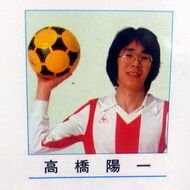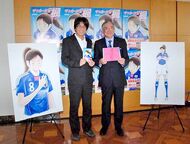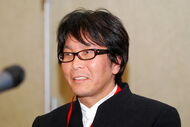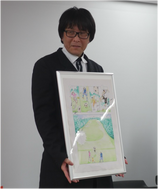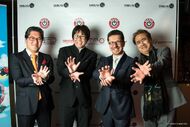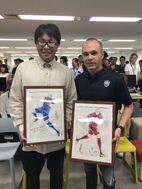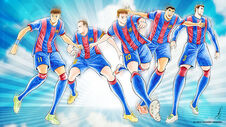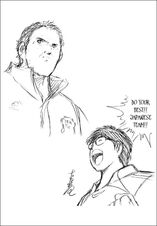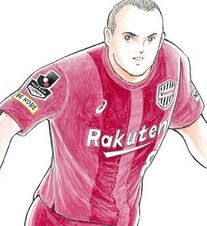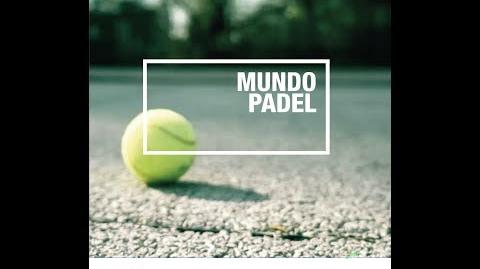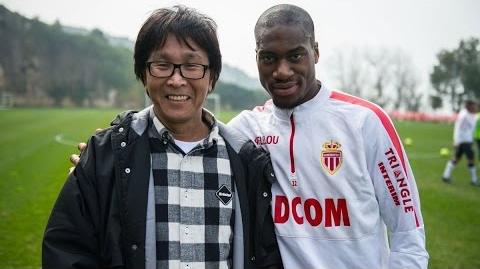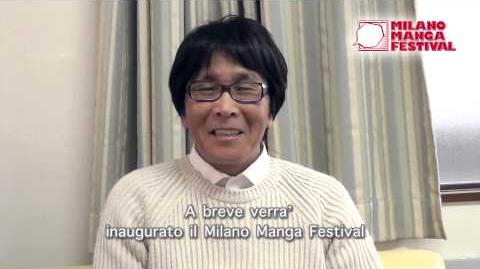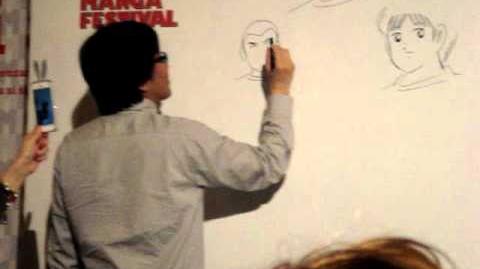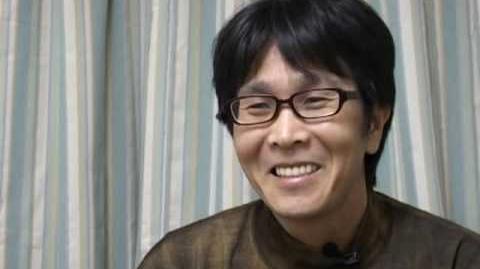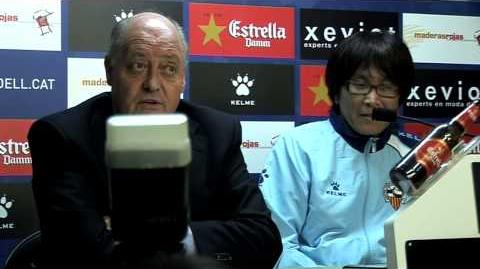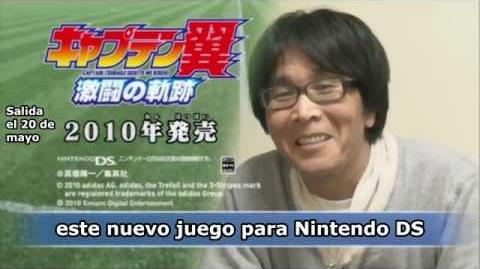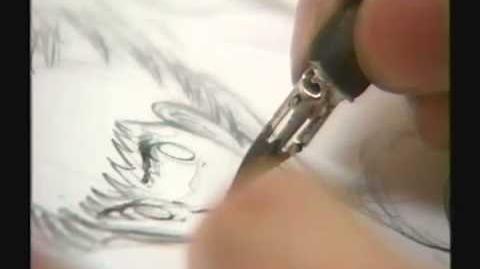|
Yoichi Takahashi
| |
|
Birthday
|
1960-07-28
|
|
Nationality
|
Japanese
|
|
Residence
|
|
|
Occupation
|
|
|
Manga genres
|
Sports, drama, romance
|
|
Prominent works
|
|
|
Relatives
|
Akari Hibino (wife)
|
|
Years active
|
1980~present
|
Yoichi Takahashi (高橋陽一, Takahashi Youichi, born July 28, 1960), also known as Taka-sensei, is a famous mangaka, best known for his work Captain Tsubasa. Takahashi has always been a sports fan, but mostly a fan of football (soccer). Captain Tsubasa, his most famous work lasted for 8 years in the shonen manga anthology Weekly Shonen Jump. Weekly Shonen Jump has serialized two major series, Captain Tsubasa and Captain Tsubasa: World Youth. The later works of Yoichi Takahashi have been published in the seinen manga anthology Weekly Young Jump. Most of Takahashi's manga are about football, with some exceptions like Chibi (boxing), Sho no Densetsu (tennis), and Ace! (baseball). He is recently drawing Captain Tsubasa: Rising Sun in Grand Jump.
In addition to drawing manga, Takahashi also wrote novels for children and teenagers, Golden Kids, which received an animated episode released on the iOS, and Soccer Shojo Kaede.
Profile[]
Early life[]
Takahashi was born in Yotsugi, Katsushika, Tokyo. His blood type is A. He graduated from South Katsushika High School. His wife is voice actress Akari Hibino.
From an early age, Takahashi started drawing. While first dreaming of becoming a baseball player prior to elementary school, even as a child, from around ten to twelve years old, Takahashi wanted to be a mangaka and his favorite manga was Ashita no Joe.[1][2]
Career[]
After finishing high school, instead of going to college, Takahashi focused on drawing. During this time he developed some of his amateur works. He took these works to Shueisha.[1] His Yujo no Eleven manga drew the attention of the editorial who decided to recruit him. Takahashi started his career as an assistant of mangaka Shinji Hiramatsu.
While already a fan of sports, Takahashi became particularly interested in football after watching Argentina 78.[3][4] What Takahashi liked the most about football was the freedom it has, very contrasting with his experiences with baseball.[3] The performance of Mario Kempes in Argentina 78 dazzled Takahashi, and the emotions and feelings that the sport generated with the spectators convinced him to promote football in Japan through manga.[4]
At 19 years old, Takahashi submitted his Captain Tsubasa oneshot to Shueisha and was selected as one of the winners of the 10th Fresh Jump Award. His story was published in issue #18 of 1980 of Weekly Shonen Jump, #1980-05-05, released on 1980-04-01. The oneshot was successful and Takahashi was given the green light to serialize the story.
In 1981, the Captain Tsubasa comic series was first published in Shueisha's Weekly Shonen Jump in issue #18 or #1981-04-13. While a football manga was unusual at the time, it was well-received, so Takahashi was allowed to continue doing the series.[1] At the time, Captain Tsubasa shared space in Weekly Shonen Jump with some of the biggest series of all time, such as Dr. Slump, Dragon Ball, Hokuto no Ken, Kinnikuman, Saint Seiya and many others, quite a feat for a new series by a novice mangaka dedicated to a then-unknown sport, and it's considered as one of the main franchises of the Golden Age of Shonen Jump. Takahashi also considers this period as the best era of Shonen Jump.[1]
The popularity of the comic series eventually led to the 1983 TV animated series of the same name, which was first broadcast by TV Tokyo. Tsubasa Ozora, the titular character, was voiced by Takahashi's future wife Akari Hibino (then going by her birth name Yoko Ogai) whom Takahashi would eventually meet through the production of the animation.
The animated version was successful in Japan and, eventually, also abroad. The TV series would spawn four movies. Many professional footballers, both from Japan and abroad, took inspiration to take up the sport as a consequence of watching the first animated series. It is often said that the current Japanese football scene would not exist without the advent of Captain Tsubasa.
The Captain Tsubasa comic series ran between 1981 and 1988, from issue #18 of 1981 to issue #22 of 1988, spanning a total of 356 chapters in magazine serialization. In the meantime, Takahashi also created other short comics focused on other sports, such as 100m Jumper, Subaru, Basuke and even a special story dedicated to Taro Misaki, Boku wa Misaki Taro.
After ending the Captain Tsubasa series, Takahashi turned his efforts towards three other sports series: Sho no Densetsu (1988-89, focused on tennis), Ace! (1990-91, focused on baseball) and Chibi (1992-93, focused on boxing). The first one is considered unsuccessful as it was expected to become the next big sports comic and it barely managed to get three volumes compiled, with Takahashi apologizing for being unable to reach more than one-tenth of his original design for the series. Ace!, on the other hand, was relatively successful, as it completed the story and was collected in nine volumes that were later reprinted in two other different editions. Contrary to the previous two, Chibi was left in the middle, more successful than Sho no Densetsu, but not to the level of Ace!. While Chibi had a promising potential, it was cut short by Takahashi. During its serialization Takahashi decides to create a short five-part sequel to the original Captain Tsubasa series that piqued both his interest and the public's: Captain Tsubasa: Saikyo no Teki! Holanda Youth.
After the bankruptcy of Tsuchida Production, the studio that animated Captain Tsubasa, the TV series ended abruptly and left the plot unresolved without finishing the last story arc of the manga. The public was still interested in watching the rest of the story so, Shueisha, in conjunction with Animate Film and CBS Sony Group, produced Shin Captain Tsubasa, an original video animation (OVA) released from 1989 to 1990, keeping the voice cast from the original TV series. The OVA series was a success despite being released three years after the end of the TV show.
Prior to the OVA, Tecmo started its successful Captain Tsubasa videogame series with Captain Tsubasa for the Famicom in 1988. The sequel, Captain Tsubasa 2: Super Striker, released right after the last episode of the OVA series in 1990, continued the story with a new original plot that would span five other games in a successful series for Tecmo, all with the involvement of Takahashi.
Both the OVA and the videogames showed that Captain Tsubasa was still in the mind of the public. But what moved Takahashi to create a true sequel was the founding of the J.League in 1992. The short story Saikyo no Teki! Holanda Youth, proved to be so successful that it convinced Takahashi to drop Chibi to refocus his efforts on Captain Tsubasa once again as he realized that he loved football and missed it.
In 1994, Captain Tsubasa: World Youth Hen started being serialized in Shueisha's Weekly Shonen Jump with the first five chapters dedicated to the story of Shingo Aoi under the then-temporary title Captain Tsubasa: Principe del Sole. The same year, Shueisha produced the animated film Captain Tsubasa: Saikyo no Teki! Holanda Youth.
During World Youth Hen, Takahashi fully dedicated himself to the series and didn't author other comics as was the case with the original series. Also, Takahashi's drawing style evolved in this period, particularly notable when looking at the collected volume of Saikyo no Teki! Holanda Youth, which included a few new pages no present in the magazine serialization that had a different art style.
Along with World Youth Hen and the Saikyo no Teki! Holanda Youth OVA, a new TV anime adaptation, Captain Tsubasa J, was released in 1994, this time animated by Studio Comet (which was formed by former employees of the studio that animated the original series). The new TV series, which retold parts of the original story plus parts of World Youth Hen, was also successful, but, eventually, was also cut short due to budget constraints.
Despite the success of the World Youth Hen comic, the serialization ran into problems between Takahashi and Shueisha, essentially creative differences that forced a rushed ending to the series.[1] After the end of World Youth Hen in 1997, Takahashi created two short stories dedicated to football, Keeper Coach and Koshu! before trying his hand on a new serialization: Shukyuden: Field no Okami Striker Jin!.
With Striker Jin, which had a short serialization in Weekly Shonen Jump in 1999, Takahashi tried to correct an unintended effect caused by the success of Captain Tsubasa. Most Japanese children tried to emulate Tsubasa and become midfielders, which meant that most of them weren't natural strikers once they became professional footballers, reflected in the fact that the most famous Japanese stars of the time were midfielders. To address this, Takahashi tried to create a hit series that would focus on a striker protagonist (as implied by the title) so that future generations of players would get inspired to become strikers, something that the Japan national football team lacked the most at the time. The series also shares the same universe with Captain Tsubasa as revealed towards the end. Unfortunately, the series did not succeed as planned and barely managed to have 17 chapters collected in two volumes, even less than Sho no Densetsu, in great part due to its similarities with Captain Tsubasa.
In 2000, in commemoration of Japan's participation in the football tournament of Sydney 2000, Takahashi created a special one-shot that was published in Shueisha's young adult magazine Weekly Young Jump, Captain Tsubasa 2000: Millennium Dream. An imaginary tale that combined real-life players with characters from the series, the story jokes that the series was supposed to have ended with World Youth and that Tsubasa and the others are older than how they are presented in the one-shot. The one-shot served to rekindle interest in Captain Tsubasa.
Towards the end of 2000, with the interest generated by Millennium Dream and Korea Japan 2002 looming, Takahashi started a new Captain Tsubasa series titled Captain Tsubasa: Road to 2002 which further advances the story after World Youth Hen. Along with the new comic series, in 2001 a new animated series, titled once again Captain Tsubasa, was released. The plot followed the original story, adding elements of the Road to 2002 comic in the later episodes. While the TV show only ran for a year, the comic series ended in 2004.
Korea Japan 2002 not only allowed Takahashi to start a new Captain Tsubasa series but also gave him a chance to correct what he couldn't do with Striker Jin. Nippon Animation, thinking about the looming World Cup, approached Takahashi to request him to develop a football series different from Captain Tsubasa. Thus, Takahashi created the comic Hungry Heart, which was published by Akita Shoten in its magazine Weekly Shonen Champion, while Nippon Animation developed the TV animation Hungry Heart: Wild Striker, both with the same concept, but with some differences in their focus, the comic being slightly more serious and with a longer story, while the anime has more comedy and a different ending.
Hungry Heart proved to be a big success, both in its comic and animated incarnations, allowing Takahashi to fulfill his goal of creating a story with a striker as a protagonist that could inspire future generations to become forwards. The series was also popular outside Japan, becoming the second most successful work of Takahashi. It also represented the first series of Takahashi that was not published by Shueisha and would eventually lead to Takahashi working with other publishers.
Since he was working on Road to 2002 at the same time, Takashi was unable to focus exclusively on the Hungry Heart comic during the first two years of its run, which led to chapters being published irregularly, but, once Road to 2002 was done, Takahashi focused on properly finishing Hungry Heart.
While Hungry Heart was a smashing success, Takahashi decide to once again return to his magnum opus. In 2004, as a promotional item for the F.C.R.B. Stadium Project, Takahashi created the short Captain Tsubasa: Road to 2002 Tokubetsu Hen - F.C.R.B. Stadium Opening Match and soon after Captain Tsubasa: Golden Dream for the match between Barcelona and Jubilo Iwata that took place in Japan as part of Barcelona's Asian tour. Shortly thereafter, with the twenty-fifth anniversary of Captain Tsubasa approaching, Takahashi created the five-part story Captain Tsubasa 25th Anniversary, a dream match with the most popular characters of the franchise.
In the year of the twenty-fifth anniversary, Takahashi created a new sequel to the Captain Tsubasa series with a new story focused on the Olympics: Captain Tsubasa: Golden-23. The series ran from 2005 to 2008 in Shueisha's Weekly Young Jump. After the end of the series and as part of the twenty-fifth anniversary of the franchise, Takahashi created the short story Captain Tsubasa: Endless Dream, which was published in Shueisha's Weekly Shonen Jump, Takahashi's first comic to be published in that magazine since 1999. The story takes place within the original series, just at the end of the Kids' Dream storyline.
After the end of Golden-23, Takahashi tried his hand at writing a novel. Since working on two different comic projects at the same time took him too much effort and unnecessary delays for his works with Road to 2002 and Hungry Heart, Takashi opted to write a novel instead of a second comic. Thus, Takahashi wrote Golden Kids, a light novel about children's football with a goalkeeper as the protagonist, a series intended for people who don't play football. The novel was successful and Takahashi created a sequel titled Golden Kids 2.
In 2009, Takahashi followed the Captain Tsubasa series with the comic Captain Tsubasa: Kaigai Gekito Hen in Calcio - Hi Izuru Kuni no Giocatore, focused on Kojiro Hyuga's struggle in Italy, and in 2010 with Captain Tsubasa: Kaigai Gekito Hen en La Liga, focused on Tsubasa's Barcelona competition with Natureza's Real Madrid, both serialized in Shueisha's Weekly Young Jump.
In 2011, Takahashi's Golden Kids was adapted into an original net animation. Two episodes were released, but, for unknown reasons, no more episodes were produced. The same year, Takahashi produced his second comic series outside Shueisha. With a far more mature and complex approach than anything he had previously created, Takahashi developed Pride, a series focused on the struggles of former football stars in lower leagues once their prime has passed. The series was published by Nihon Bungeisha in its Weekly Manga Goraku, a comic magazine for adult men. Takahashi took inspiration in how many Japanese footballers keep on playing well after their peak has passed, motived only by the pride they have as footballers.[5] A successful series, due to Takahashi's other endeavors, Pride was serialized first in 2011 and the rest in 2013. The series was also released in Italy and Brazil.
During the serialization of Pride, Takahashi found himself busy with other affairs after an event took by surprise the Japanese football scene: Nadeshiko Japan won the 2011 FIFA Women's World Cup. Takahashi, who has always supported all football-related activities in Japan, had become particularly interested in Nadeshiko Japan when the team qualified for the 2007 FIFA Women's World Cup. After Nadeshiko Japan's performance in Beijing 2008, Takahashi decided to create a story for women's football in the style of Captain Tsubasa to support them.[6] Believing that they would have a high chance of performing very well during London 2012, to support the team, both in the upcoming Olympics and the Women's World Cup. Takahashi first created a mascot, Kaede, a character based on Homare Sawa, the captain and symbol of Nadehisko Japan whom Takahashi had previously interviewed about her life. Takahashi also started developing a novel inspired on the life of Sawa titled Soccer Shojo Kaede to be released once the team had qualified for London 2012. When Nadeshiko Japan unexpectedly defeated Germany, the host and favorite to win the 2011 FIFA Women's World Cup, Takahashi quickly traveled to Germany to support them, giving the team a Japanese flag with the drawings of Tsubasa Ozora and Kaede, which Sawa displayed after they defeated the US team.[7] With such an achievement, Takahashi changed his plans and forced himself to quickly finish the novel to release it a little after a month of Nadeshiko Japan's feat instead of the London 2012 qualification.
After a busy 2012, in which Takahashi traveled to Sabadell to draw a mural in the Estadi de la Nova Creu Alta for the CE Sabadell FC, [1][8], Takahashi focused on finishing Pride in 2013. Towards the end of the year, he also worked in illustrating the Captain Tsubasa novel for kids. That year, Takahashi also traveled to Italy for the Milano Manga Festival in May and to Spain in November for the XIX Salón del Manga de Barcelona. At the end of the year, Takahashi also opened the Manga Academy Tsubasa Juku (マンガアカデミー翼塾)[9] which started operating in January 2014.[10] Also in 2013, the local government of Katsushika, the ward where Takahashi was born, installed in March a bronze statue of Ozora Tsubasa to honor Takahashi and his work, and in March of 2014 seven new statues of other characters of Captain Tsubasa were also installed.[11]
In 2014, Takahashi retook the Captain Tsubasa story where he had left it and started a new comic series: Captain Tsubasa: Rising Sun. This time, the focus is the quest to win a medal at the Olympic games. Takahashi also worked on the comic adaptation of his own Golden Kids novel with the equally named manga published in collected volumes after being first serialized in mobile phones. In June of the same year, Takahashi traveled to Hong Kong.[12]
During a busy 2015, Takahashi was designated as the ambassador of footgolf in Japan, [13] traveled to the Monaco Anime Game International Conferences (MAGIC) at the Grimaldi Forum[14] and to La Turbie to visit the AS Monaco[15] in Monaco, gave a short manga course in the Escola Joso in Barcelona[16] and went to Singapore for the SJ49 Friendship Singapore Tour 2015,[17] among many other activities. Takahashi also made several drawings of football stars, such as James Rodríguez [18] and the stars of FC Barcelona.[19]
As of 2024, Takahashi announced that after the publication of the final chapter of Rising Sun, he would retire from drawing and serializing manga in April 2024, citing age and health concerns[20]. However, he does not excludes the possibility of drafting storyboards which could continue the story past the manga's final chapters[21].
Comics[]
Long comic series[]
- Captain Tsubasa (1981-1988, Weekly Shonen Jump) - Football
- Sho no Densetsu (1988-1989, Weekly Shonen Jump) - Tennis
- Ace! (1990-1991, Weekly Shonen Jump) - Baseball
- Chibi (1992-1993, Weekly Shonen Jump) - Boxing
- Captain Tsubasa: World Youth Hen - (1994-1997, Weekly Shonen Jump) Football
- Shukyuden: Field no Okami Striker Jin! (1999, Weekly Shonen Jump) - Football
- Captain Tsubasa: Road to 2002 (2001-2004, Weekly Young Jump) - Football
- Hungry Heart (2002-2004, Weekly Shonen Champion) - Football
- Captain Tsubasa: Golden-23 (2005-2008, Weekly Young Jump) - Football
- Captain Tsubasa: Kaigai Gekito Hen in Calcio - Hi Izuru Kuni no Giocatore (2009, Weekly Young Jump) - Football
- Captain Tsubasa: Kaigai Gekito Hen en La Liga (2010-2011, Weekly Young Jump) - Football
- Pride (2011-2013, Weekly Manga Goraku) - Football
- Captain Tsubasa: Rising Sun (2014-ongoing, Grand Jump) - Football
- Golden Kids (2014-2015) - Football
Short comic series[]
- Captain Tsubasa (one-shot) (1980, Weekly Shonen Jump) - Football
- 100m Jumper (1982, Weekly Shonen Jump) - Ski jumping
- Hatsukoi Doshi (1982, Fresh Jump) - Kendo
- Subaru (1983, Weekly Shonen Jump) - Boxing
- Todoroki Genta Ipponshobu (1983, Fresh Jump) - Judo
- Boku wa Misaki Taro (1984, Fresh Jump) - Football
- Captain Tsubasa Special Hen: Yume no Brazil Pro-Debut no Maki (1985, Captain Tsubasa Netto Special) - Football
- Sotsugyo: 100m Jumper 2 (1985, Weekly Shonen Jump) - Ski jumping
- Basuke (1987, Weekly Shonen Jump) - Basketball
- Hokuheki Downhiller!! (1989, Weekly Shonen Jump) - Alpine skiing
- Chibi (one-shot) (1992, Weekly Shonen Jump) - Boxing
- Captain Tsubasa: World Youth Tokubetsu Hen - Saikyo no Teki! Holanda Youth (1993, Weekly Shonen Jump) - Football
- Keeper Coach (1998, Shonen Jump Sports Special '98) - Football
- Koshu! (1998, Weekly Shonen Jump) - Football
- Captain Tsubasa 2000: Millennium Dream (2000, Weekly Young Jump) - Football
- Captain Tsubasa: Road to 2002 - Final Countdown (2002, Weekly Young Jump) - Football
- Captain Tsubasa: Road to 2002 - Go for 2006 (2004, Weekly Young Jump) - Football
- Captain Tsubasa: Road to 2002 Tokubetsu Hen - F.C.R.B. Stadium Opening Match (2004, Mankaku) - Football
- Captain Tsubasa: Golden Dream (2004, Weekly Young Jump) - Football
- Captain Tsubasa 25th Anniversary (2005, Weekly Young Jump) - Football
- Captain Tsubasa: Golden-23 - Japan Dream 2006 (2006, Weekly Young Jump) - Football
- Captain Tsubasa: Endless Dream (2008, Weekly Shonen Jump) - Football
- Captain Tsubasa: Golden-23 - Wish for Peace in Hiroshima (2008, Monthly Young Jump) - Football
- Captain Tsubasa Tokubetsu Hen: Live Together 2010 (2010, Monthly Young Jump) - Football
- Captain Tsubasa Memories (2018, Grand Jump Premium) - Football
Novels[]
- Golden Kids (2008) - Football
- Golden Kids 2 (2009) - Football
- Soccer Shojo Kaede (2011) - Football
- Captain Tsubasa Mirai Bunko (2013) - Football [Illustrator]
Others[]
- Captain Tsubasa 3109 Nichi Zenkiroku (2003) - Databook of Captain Tsubasa
- Habatake! Ketta (2008) - Comic strip for the Yokohama FC match programs
Amateur works[]
- Main article: Amateur works of Yoichi Takahashi
- Yuju no Eleven (between 1976~1978)
- Onboro Angels (1979)
- Bancho Keeper (between 1979~1980)
- Akuyu Battery (between 1979~1980)
Works of other cartoonists in which Takahashi was an assistant[]
Shinji Hiramatsu
- Doberman Deka
- Ricky Taifu
Animations based on works of Takahashi[]
- Captain Tsubasa (1983 TV series)
- Captain Tsubasa: Europe Daikessen (1985 film)
- Captain Tsubasa: Ayaushi! Zen Nihon Jr. (1985 film)
- Captain Tsubasa: Asu ni Mukatte Hashire! (1986 film)
- Captain Tsubasa: Sekai Daikessen!! Jr. World Cup (1986 film)
- Shin Captain Tsubasa (1989 OVA)
- Captain Tsubasa: Saikyo no Teki! Holanda Youth (1994 film)
- Captain Tsubasa J (1994 TV series)
- Captain Tsubasa (2001 TV series)
- Hungry Heart: Wild Striker (2002 TV series)
- Golden Kids (2011 ONA)
- Captain Tsubasa (2018 TV series)
Gallery[]
Videos[]
References[]
- ↑ 1.0 1.1 1.2 1.3 1.4 1.5 "Entrevista a Yoichi Takahashi" [Yoichi Takahashi interview] (in Spanish). Mision Tokyo. 2012-11-24. Retrieved 2018-06-22.
- ↑ "El creador de “Oliver y Benji” se inspiró en el Barça" [“Captain Tsubasa” creator got inspired by Barça] (in Spanish). MARCA.com. 2013-11-01. Retrieved 2018-07-12.
- ↑ 3.0 3.1 "Yoichi Takahashi: “El futbolista Oliver Atom sería Iniesta”" ["Yoichi Takahashi: “Footballer Oliver Atom would be Iniesta”"] (in Spanish). 20 minutos. 2013-11-01. Retrieved 2018-06-22.
- ↑ 4.0 4.1 "Supercampeones | Yoichi Takahashi: “Eso de Oliver en un hospital es una leyenda, no es real”" ["Supercampeones | Yoichi Takahashi: “That thing about Oliver in a hospital is a myth, it's not real”"] (in Spanish). Elcomercio.pe. 2017-09-23. Retrieved 2018-06-22.
- ↑ "「漫画家としての誇りは●●」『キャプ翼』高橋陽一が新作発売記念サイン会を開催" ["Pride as a cartoonist..." Captain Tsubasa's Yoichi Takahashi holds a commemorative autograph session for a new work release.] (in Japanese). Daily Cyzo. cyzo. 2012-01-16. Retrieved 2018-07-09.
- ↑ "漫画家・高橋陽一が、あえて“小説”で伝えたかったこと。~『サッカー少女 楓』執筆の理由~" [What comic artist Yoichi Takahashi wanted to convey in a daring "novel": The reason to write 'Soccer Shojo Kaede'] (in Japanese). Number Web. Bungeishunju. 2011-10-10. Retrieved 2018-07-09.
- ↑ Tada, Akiko (2011-08-31). "Nadeshiko Japan captain stars in new manga novel". Asia & Japan Watch. The Asahi Shimbun. Archived from the original on 2015-10-28. Retrieved 2018-07-09.
- ↑ "Yoichi Takahashi: “I draw at night, watching Barcelona”". Marca.com. 2012-11-16. Retrieved 2018-07-11.
- ↑ "Captain Tsubasa's Youichi Takahashi to Open Manga Academy in December". Anime News Network. 2013-11-09. Retrieved 2018-07-15.
- ↑ "「キャプテン翼」の高橋陽一が塾長。 『マンガアカデミー翼塾』が2014年1月入校生の募集を受付中。" [Yoichi Takahashi of "Captain Tsubasa" is the principal of a private school. "Manga Academy Tsubasa Juku" is accepting enrollment applications for entrance in January 2014.] (in Japanese). Techinsight. 2014-01-01. Retrieved 2018-07-15.
- ↑ "‘Capt. Tsubasa’ manga character statues erected". National. The Japan Times. 2014-03-18. Retrieved 2018-07-15.
- ↑ Nip, Amy (2014-06-28). "Cartoonist's World Cup draw". Culture. South China Morning Post. Retrieved 2018-07-18.
- ↑ "Yoichi Takahashi is the ambassador in Japan". Federation for International FootGolf. 2015-02-18. Retrieved 2018-07-18.
- ↑ "MAGIC 2015 - Yôichi Takahashi : « je serais très intéressé de voir un jeu "Olive et Tom" qui utiliserait les technologies de dernière génération »" [MAGIC 2015 - Yoichi Takahashi: “I'd be very interested in seeing a "Captain Tsubasa" game that used the last generation technologies”] (in French). Gamergen.com. 2015-03-29. Retrieved 2018-07-18.
- ↑ Pelayo, Yannick (2015-03-21). "The creator of Olive and Tom at La Turbie". News. asmonaco.com. Retrieved 2018-07-18.
- ↑ "Yoichi Takahashi, autor de ‘Oliver y Benji’, impartirá un curso en Escola Joso" [Yoichi Takahashi, ''Captain Tsubasa'' author, will give a course in Escola Joso] (in Spanish). Deculture.es. 2015-04-21. Retrieved 2018-07-18
- ↑ Yoichi Takahashi SJ49 Friendship Singapore Tour 2015 Helped to Raise S$6000 for Singapore Cerebral Palsy Football Team. Institute for Future Asian Football. 2015-11-26. Retrieved 218-07-18.
- ↑ "Así luciría James Rodríguez si fuera un personaje de la serie 'Supercampeones'" [This is how James Rodríguez would look if he were a character of the 'Captain Tsubasa' series] (in Spanish). Deportes. Elpais.com.co. 2015-07-21. Retrieved 2018-07-18.
- ↑ The artist Yoichi Takahashi with Barça. Pàgina Oficial del FC Barcelona. 2015-12-20. Retrieved 2018-07-18.
- ↑ https://www.animenewsnetwork.com/news/2024-01-04/captain-tsubasa-creator-youichi-takahashi-to-retire-from-serializing-manga/.206163
- ↑ https://www.animenewsnetwork.com/news/2024-01-04/captain-tsubasa-creator-youichi-takahashi-to-retire-from-serializing-manga/.206163
External links[]
- Yoichi Takahashi at Twitter (Japanese)
- Yoichi Takahashi at Wikipedia
- A Soccer Hero Adored Around the World - An Interview with Captain Tsubasa Creator Takahashi Yōichi at nippon.com
- Takahahi's series digitally available at eBookJapan (Japanese)


